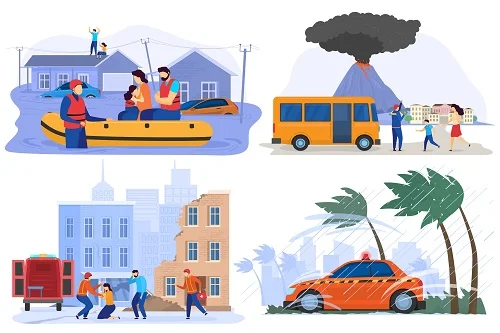Context
In late May 2021, Cyclone Yaas pounded India's eastern coastline, leaving a path of destruction in its wake. Particularly hard-hit were the states of West Bengal and Odisha, where communities faced severe damage to infrastructure and livelihoods. The cyclone's ferocity underscored the region's vulnerability to natural disasters, highlighting the urgent need for effective disaster preparedness and response measures..
Sradhanjali's Journey: A Case Study
- Sradhanjali Pattanaik's upbringing in Chanuri village exposed her to the relentless threat of cyclones and floods that plague the region during the monsoon season. Her father, a farmer, instilled in her a profound understanding of the community's vulnerability to natural disasters, sparking her passion for disaster response from a young age. As she grew older, Sradhanjali sought opportunities to equip herself with the necessary skills and knowledge to make a difference.
- During her college years, Sradhanjali participated in disaster preparedness courses, where she learned about the importance of early warning systems, evacuation procedures, and community resilience. In 2019, she joined the Reliance Foundation Youth Volunteer program, immersing herself in disaster response initiatives and outreach activities. Despite the challenges posed by the COVID-19 pandemic, Sradhanjali remained steadfast in her commitment to supporting her community, coordinating relief efforts, and raising awareness about health emergencies.
Lessons in Disaster Preparedness
- Capacity Building for Community Leaders: Short-term training courses provide local leaders like Sradhanjali with the knowledge and skills needed to effectively engage their communities in disaster preparedness activities. These courses empower individuals to raise awareness, mobilize resources, and coordinate response efforts during times of crisis.
- Community Support and Collective Action: The success of disaster response efforts hinges on the support and involvement of the community. Sradhanjali's collaboration with fellow volunteers exemplifies the power of collective action in extending humanitarian assistance and fostering resilience. By working together, communities can overcome challenges and emerge stronger in the aftermath of disasters.
- 'Stronger Together' and Building Resilience: A Compendium of Stories of Courage and Resilience During Disasters' serves as a testament to the resilience and determination of individuals like Sradhanjali, whose efforts have strengthened their communities in the face of adversity. The publication showcases inspiring stories of courage and leadership, offering valuable insights into effective disaster preparedness and response strategies.
-
- Empower grassroots communities through training and capacity building to foster a network of capable responders, ensuring sustainable growth and well-being amidst challenges like the COVID-19 pandemic.
- Leverage multi-stakeholder partnerships to strengthen community resilience, offering innovative frameworks for sustaining livelihood opportunities, exemplified by initiatives like the Mahila Sangh (Women’s Self-Help Group).
- Foster local leadership at the grassroots level to effectively lead and support affected communities during emergencies, mobilize resources, and identify immediate needs for relief and assistance.
- Raise awareness about disaster risks, early warning systems, and preparedness measures through demonstration programs, reducing reliance on external aid and enhancing community resilience in handling crises.
- Promote co-production of knowledge by integrating local knowledge, traditional practices, and understanding of local priorities and perceptions, facilitating improved communication and adaptive capacity.
- Facilitate knowledge-sharing through 'learning communities' to exchange insights on traditional disaster mitigation methods, contributing to the development of resilient communities.
- Strengthen local systems to cope with and recover from climate shocks, ensuring the well-being and prosperity of communities in a changing climate.
India's Increasing Vulnerability to Disasters
India's vulnerability to climate change-induced disasters has become increasingly evident in recent years. Events such as Cyclone Tauktae and the COVID-19 pandemic have highlighted the urgent need for comprehensive resilience-building strategies. With floods, cyclones, heatwaves, and pandemics becoming more frequent and intense, the need for proactive measures to mitigate risks and enhance resilience has never been more pressing.
The Imperative of Disaster Risk Reduction (DRR)
India's comprehensive approach to disaster management emphasizes the importance of resilience, adaptation, and public health strategies. The 10-point agenda on Disaster Risk Reduction (DRR) outlines key priorities for enhancing the country's resilience against disasters, including the vital role of sustained collective action and local leadership.
Localisation of Disaster Risk Reduction Efforts
The National Platform for Disaster Risk Reduction (NPDRR) recognizes the importance of localizing disaster risk management efforts. By leveraging local expertise, empowering communities, and fostering multi-stakeholder partnerships, India can enhance its capacity to respond effectively to emerging disaster patterns and reduce vulnerability at the grassroots level.
Empowering Women's Leadership in Disaster Risk Management
Women's leadership is central to effective disaster risk management. The 3rd session of the NPDRR highlighted the importance of enabling women's leadership in building local resilience, recognizing women's unique contributions to disaster preparedness, response, and recovery efforts.
Conclusion:
The stories documented in 'Stronger Together' offer valuable insights into shaping future strategies for building community resilience. By nurturing local leadership, fostering multi-stakeholder partnerships, and promoting knowledge-sharing, India can strengthen its capacity to respond effectively to disasters and minimize the impact on vulnerable communities.
As India and other nations confront the escalating challenges of climate change-induced disasters, investing in resilience and adaptation becomes paramount. By empowering local communities, leveraging local knowledge, and fostering collaborative partnerships, we can build resilient frameworks capable of withstanding and overcoming future crises.
Through collective action and shared commitment, we can forge a path towards a more resilient future, where communities stand stronger together in the face of adversity. Sradhanjali Pattanaik's story serves as a testament to the resilience and determination of individuals working tirelessly to safeguard their communities amidst the most challenging circumstances.
|
Probable Questions for UPSC Mains Exam-
|
Source- ORF







